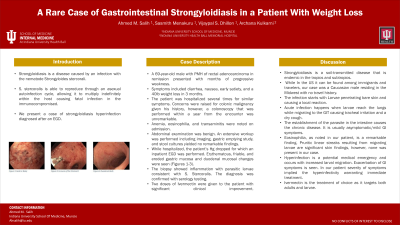Back


Poster Session D - Tuesday Morning
Category: Stomach
D0704 - A Rare Case of Gastrointestinal Strongyloidiasis in a Patient With Weight Loss
Tuesday, October 25, 2022
10:00 AM – 12:00 PM ET
Location: Crown Ballroom

Has Audio

Ahmed M. Salih, MBChB
Indiana University Health Ball Memorial Hospital
Muncie, IN
Presenting Author(s)
Ahmed M. Salih, MBChB1, Sasmith R. Menakuru, MD1, Vijaypal S. Dhillon, MD2, Archana Kulkarni, MD3
1Indiana University Health Ball Memorial Hospital, Muncie, IN; 2IU Health Ball Memorial, Muncie, IN; 3IU Ball Memorial Hospital, Muncie, IN
Introduction: Strongyloidiasis is a disease caused by an infection with the nematode Strongyloides stercorali. S. stercoralis is able to reproduce through an asexual autoinfection cycle, allowing it to multiply indefinitely within the host causing fatal infection in the immunocompromised. We present a case of strongyloidiasis hyperinfection diagnosed after an EGD.
Case Description/Methods: A 69-year-old male with PMH of rectal adenocarcinoma in remission presented with months of progressive weakness. Symptoms included diarrhea, nausea, early satiety, and a 40lb weight loss in 3 months. The patient was hospitalized several times for similar symptoms. Concerns were raised for colonic malignancy given his history, however, a colonoscopy that was performed within a year from the encounter was unremarkable.
Anemia, eosinophilia, and transaminitis were noted on admission. Abdominal examination was benign. An extensive workup was performed including imaging, gastric emptying study, and stool cultures yielded no remarkable findings.
While hospitalized, the patient’s Hg dropped for which an inpatient EGD was performed. Erythematous, friable, and eroded gastric mucosa and duodenal mucosal changes were seen (Figures 1-3). The biopsy showed inflammation with parasitic larvae consistent with S. Stercoralis. The diagnosis was confirmed with serology testing. Two doses of Ivermectin were given to the patient with significant clinical improvement.
Discussion: Strongyloidiasis is a soil-transmitted disease that is endemic in the tropics and subtropics. While In the US it can be found among immigrants and travelers, our case was a Caucasian male residing in the Midwest with no travel history.
The infection starts with Larvae penetrating bare skin and causing a local reaction. Acute infection happens when larvae reach the lungs while migrating to the GIT causing tracheal irritation and a dry cough.
The establishment of the parasite in the intestine causes the chronic disease. It is usually asymptomatic/mild GI symptoms. Eosinophilia, as noted in our patient, is a remarkable finding. Pruritic linear streaks resulting from migrating larvae are significant skin findings, however, none was present in our case.
Hyperinfection is a potential medical emergency and occurs with increased larval migration. Exacerbation of GI symptoms is seen. In our patient severity of symptoms implied the hyperinfectivity warranting immediate treatment. Ivermectin is the treatment of choice as it targets both adults and larvae.

Disclosures:
Ahmed M. Salih, MBChB1, Sasmith R. Menakuru, MD1, Vijaypal S. Dhillon, MD2, Archana Kulkarni, MD3. D0704 - A Rare Case of Gastrointestinal Strongyloidiasis in a Patient With Weight Loss, ACG 2022 Annual Scientific Meeting Abstracts. Charlotte, NC: American College of Gastroenterology.
1Indiana University Health Ball Memorial Hospital, Muncie, IN; 2IU Health Ball Memorial, Muncie, IN; 3IU Ball Memorial Hospital, Muncie, IN
Introduction: Strongyloidiasis is a disease caused by an infection with the nematode Strongyloides stercorali. S. stercoralis is able to reproduce through an asexual autoinfection cycle, allowing it to multiply indefinitely within the host causing fatal infection in the immunocompromised. We present a case of strongyloidiasis hyperinfection diagnosed after an EGD.
Case Description/Methods: A 69-year-old male with PMH of rectal adenocarcinoma in remission presented with months of progressive weakness. Symptoms included diarrhea, nausea, early satiety, and a 40lb weight loss in 3 months. The patient was hospitalized several times for similar symptoms. Concerns were raised for colonic malignancy given his history, however, a colonoscopy that was performed within a year from the encounter was unremarkable.
Anemia, eosinophilia, and transaminitis were noted on admission. Abdominal examination was benign. An extensive workup was performed including imaging, gastric emptying study, and stool cultures yielded no remarkable findings.
While hospitalized, the patient’s Hg dropped for which an inpatient EGD was performed. Erythematous, friable, and eroded gastric mucosa and duodenal mucosal changes were seen (Figures 1-3). The biopsy showed inflammation with parasitic larvae consistent with S. Stercoralis. The diagnosis was confirmed with serology testing. Two doses of Ivermectin were given to the patient with significant clinical improvement.
Discussion: Strongyloidiasis is a soil-transmitted disease that is endemic in the tropics and subtropics. While In the US it can be found among immigrants and travelers, our case was a Caucasian male residing in the Midwest with no travel history.
The infection starts with Larvae penetrating bare skin and causing a local reaction. Acute infection happens when larvae reach the lungs while migrating to the GIT causing tracheal irritation and a dry cough.
The establishment of the parasite in the intestine causes the chronic disease. It is usually asymptomatic/mild GI symptoms. Eosinophilia, as noted in our patient, is a remarkable finding. Pruritic linear streaks resulting from migrating larvae are significant skin findings, however, none was present in our case.
Hyperinfection is a potential medical emergency and occurs with increased larval migration. Exacerbation of GI symptoms is seen. In our patient severity of symptoms implied the hyperinfectivity warranting immediate treatment. Ivermectin is the treatment of choice as it targets both adults and larvae.

Figure: EGD
Disclosures:
Ahmed Salih indicated no relevant financial relationships.
Sasmith Menakuru indicated no relevant financial relationships.
Vijaypal Dhillon indicated no relevant financial relationships.
Archana Kulkarni indicated no relevant financial relationships.
Ahmed M. Salih, MBChB1, Sasmith R. Menakuru, MD1, Vijaypal S. Dhillon, MD2, Archana Kulkarni, MD3. D0704 - A Rare Case of Gastrointestinal Strongyloidiasis in a Patient With Weight Loss, ACG 2022 Annual Scientific Meeting Abstracts. Charlotte, NC: American College of Gastroenterology.
